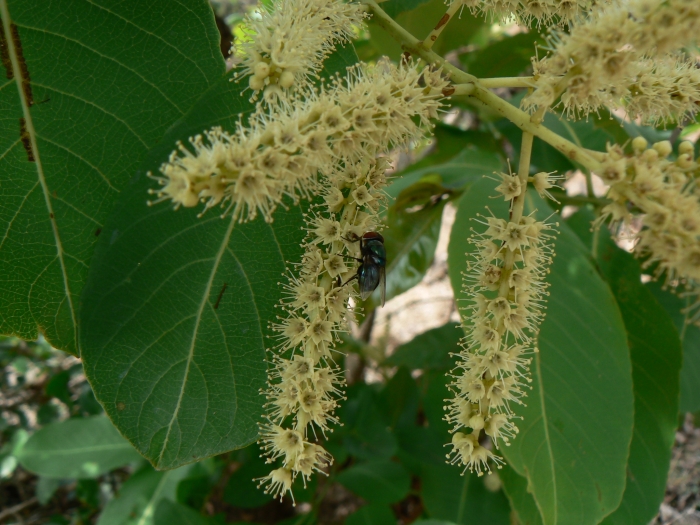Asna
(Terminalia elliptica)
Asna (Terminalia elliptica)
/
/

© Dinesh Valke
CC BY-SA 4.0
Image By:
© Dinesh Valke
Recorded By:
Copyright:
CC BY-SA 4.0
Copyright Notice:
Photo by: © Dinesh Valke | License Type: CC BY-SA 4.0 | License URL: http://creativecommons.org/licenses/by-sa/4.0/ | Uploader: dineshvalke | Publisher: iNaturalist |

























Estimated Native Range
Summary
Terminalia elliptica, commonly known as asna, Indian laurel, or crocodile bark, is a deciduous tree native to the dry and moist deciduous forests of southern and southeast Asia, including India, Nepal, Bangladesh, Myanmar, Thailand, Laos, Cambodia, and Vietnam, typically found at elevations up to 3281 feet. It can grow up to 98 feet tall with a notable straight trunk and a rounded crown. The tree’s bark resembles crocodile skin, giving it one of its common names, and it is known for its fire-resistant properties. The leaves are broadly oval, and the tree produces small, yellow to white flowers in terminal spikes, followed by winged fruits that are dispersed by wind. Flowering occurs from March to May.
Terminalia elliptica is valued for its durable, high-quality timber used in furniture, cabinetwork, joinery, and musical instruments. Its fire-resistant bark has been traditionally used in construction and medicinally against diarrhea. The tree’s cultural significance is noted in Theravada Buddhism, where it is believed to have been used by the twentieth Tissa Buddha to achieve enlightenment. In cultivation, it requires a well-drained soil, moderate water, and can tolerate a range of light conditions from full sun to part shade. While it is not commonly found in Western gardens, it can be an attractive addition to large spaces due to its impressive size and unique bark texture.CC BY-SA 4.0
Terminalia elliptica is valued for its durable, high-quality timber used in furniture, cabinetwork, joinery, and musical instruments. Its fire-resistant bark has been traditionally used in construction and medicinally against diarrhea. The tree’s cultural significance is noted in Theravada Buddhism, where it is believed to have been used by the twentieth Tissa Buddha to achieve enlightenment. In cultivation, it requires a well-drained soil, moderate water, and can tolerate a range of light conditions from full sun to part shade. While it is not commonly found in Western gardens, it can be an attractive addition to large spaces due to its impressive size and unique bark texture.CC BY-SA 4.0
Plant Description
- Plant Type: Tree
- Height: 33-98 feet
- Width: 50-70 feet
- Growth Rate: Moderate
- Flower Color: Yellow
- Flowering Season: Spring
- Leaf Retention: Deciduous
Growth Requirements
- Sun: Full Sun
- Water: Medium
- Drainage: Medium, Fast
Common Uses
Fire Resistant, Low Maintenance
Natural Habitat
Native to dry and moist deciduous forests at elevations up to 3281 feet, with a broad native range across southern and southeast Asia
Other Names
Common Names: Indian Almond, Asna, Silver Grey Wood
Scientific Names: , Terminalia elliptica, ? crenulata, ? crenulata, Chuncoa tomentosa, Chuncoa tomentosa, Pentaptera coriacea, Pentaptera crenulata, Pentaptera crenulata, Pentaptera cuneata
GBIF Accepted Name: